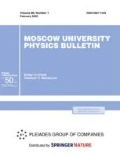Abstract
The focal mechanisms of earthquakes in the Mediterranean region that do not match the double couple focal model and that describe the complex source rupture are considered. Analysis is performed by decomposition of the observed seismic moment tensor of the strongest earthquakes into isotropic (ISO), double couple (DC), and compensated linear vector dipole (CLVD) components. There were 121 earth- quakes with magnitudes over 5.5 in the region according to the observations for 2000–2019. Of these, 57 events do not match the double couple model. The CLVD parameters are obtained for these earthquakes, and the physical interpretation of the results of the seismic moment tensor decomposition are proposed. This is the first time such an analysis is conducted. Conclusions about the features of the observed destruction processes and the structure of the medium in the focal zones are made based on the results.







Similar content being viewed by others
REFERENCES
K. Aki and P. Richards, Quantitative Seismology (University Science Books, 2009), Vol. 1.
E. V. Voronina, Earthquake Focal Mechanics. Special Course (Mosk. Gos. Univ., Moscow, 2004) [in Russian].
A. I. Lutikov, S. L. Yunga, and M. S. Kuchai, Geofiz. Issled. 11 (3), 11 (2010).
A. I. Lutikov, E. A. Rogozhin, G. Yu. Dontsova, and M. S. Kuchai, Fiz. Zemli, №2, 45 (2018).
G. R. Foulger and B. R. Julian, Encyclopedia of Earthquake Engineering (Springer, Berlin, 2015).
C. Frohlich, Phys. Earth Planet. Inter. 91, 213 (1995).
B. R. Julian, A. D. Miller, and G. R. Foulger, Rev. Geophys. 36, 525 (1998).
M. J. Randall and L. Knopoff, J. Geophys. Res. 75, 4957 (1970).
S. Yunga, A. Lutikov, and O. Molchanov, Nat. Hazards Earth Syst. Sci., Copernicus Publ. Eur. Geosci. Union 5 (1), 11 (2005).
M. W. Herman, G. P. Hayes, G. M. Smoczyk, R. Turner, B. Turner, J. Jenkins, et al., U. S. Geological Survey Open-File Report 2010–1083-Q (2015). http://dx.doi.org/10.3133/ofr20101083Q
Pino et al., Sci. Rep. 9, 2005 (2019). https://doi.org/10.1038/s41598-019-41453-1
https://earthquake.usgs.gov/search.
V. Vavryčuk, J. Geophys. Res. 106 (16), 339 (2001).
V. Vavrčyuk, Geophys. Prospect. 55, 381 (2007).
V. Vavryčuk, Tectonophysics 456, 74 (2008).
V. Vavryčuk, J. Seismol. 19 (1), 231 (2015).
E. Stierle, Geowissenschaftlichen Fakultät der Freien Universität (Berlin, 2015).
V. Vavryiuk, J. Geophys. Res. 116, B12320 (2011). https://doi.org/10.1029/2011JB008770
T. Fischer and A. Guest, Geophys. Res. Lett. 38, L05307 (2011). https://doi.org/10.1029/2010GL045447
G. F. Panza and A. Sarat, Geophys. J. Int. 143, 353 (2000).
T. Legendre, S. Meier, W. Lebedev, and L. Friederich, Geophys. J. Int. 191, 282 (2012).
Author information
Authors and Affiliations
Corresponding author
Additional information
Translated by O. Pismenov
About this article
Cite this article
Voronina, E.V. Features of the Focal Mechanisms of the Strongest Mediterranean Earthquakes. Moscow Univ. Phys. 75, 95–101 (2020). https://doi.org/10.3103/S0027134920010154
Received:
Revised:
Accepted:
Published:
Issue Date:
DOI: https://doi.org/10.3103/S0027134920010154



